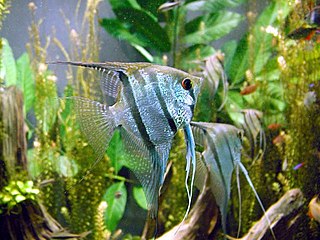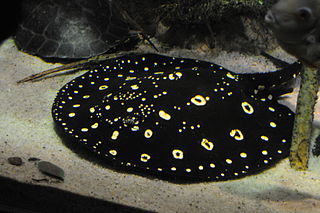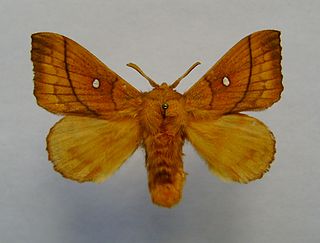
Pterophyllum is a small genus of freshwater fish from the family Cichlidae known to most aquarists as angelfish. All Pterophyllum species originate from the Amazon Basin, Orinoco Basin and various rivers in the Guiana Shield in tropical South America. The three species of Pterophyllum are unusually shaped for cichlids being greatly laterally compressed, with round bodies and elongated triangular dorsal and anal fins. This body shape allows them to hide among roots and plants, often on a vertical surface. Naturally occurring angelfish are frequently striped transversely, colouration which provides additional camouflage. Angelfish are ambush predators and prey on small fish and macroinvertebrates. All Pterophyllum species form monogamous pairs. Eggs are generally laid on a submerged log or a flattened leaf. As is the case for other cichlids, brood care is highly developed.

The bigtooth river stingray or Tocantins River ray is a species of freshwater fish in the family Potamotrygonidae. It is endemic to the lower Tocantins basin and Araguaia basin in Brazil, and prefers muddy bottoms. It is sometimes kept in aquaria. This stingray is generally common and its population increased after the Tucuruí Dam was completed, unlike many other species in its range.

The Xingu River ray, white-blotched river stingray, or polka-dot stingray is a species of freshwater fish in the family Potamotrygonidae. It is endemic to the Xingu River basin in Brazil and prefers rocky bottoms. It is sometimes kept in aquaria. The Xingu river ray is a venomous stingray that contains venom localized at its dentine spine in its tail. While the ray's venom composition does not change with maturation, the venom toxicity decreases as rays get older. On the other hand, rays’ jaw shape, stiffness, and mineralization are strengthened with age, which allows mature rays the ability to consume hard-shelled invertebrates. These changes in traits with maturation reflect the different pressures rays experience in terms of functions such as feeding and avoiding predation during different maturity stages.

Bradina is a genus of moths of the family Crambidae.
Coptobasoides is a genus of moths of the family Crambidae.

Estigena is a genus of moths in the family Lasiocampidae. It was erected by Frederic Moore in 1860. It is found throughout India, Sri Lanka, the Middle East, Myanmar and Java.

Odonestis is a genus of moths in the family Lasiocampidae described by Ernst Friedrich Germar in 1812. It consists of twenty-two species, which is found in Europe, Russia, Asia Minor, China and Japan.

Artorima is a genus of flowering plants from the orchid family, Orchidaceae. At present, only one species is known: Artorima erubescens, native to southern Mexico.

Hermann Leopoldi was an Austrian composer and cabaret star who survived Dachau and Buchenwald. Einzi Stolz, wife of composer Robert Stolz, remembered him thus:
Chebo or Chabo is an ethnic group of the south West shewa zone and West Shewa Zone of the Oromia Region of south-west Ethiopia. The Chebo speak the Oromo language but originate from a Gurage ethnic groups. their religion is Ethiopia Orthodox Christianity, The livelihood of the Chebo-Inchini area of is described as enset, barley, and cattle.
Eilema leopoldi is a moth of the subfamily Arctiinae. It is found on Java.

Coptobasoides comoralis is a moth in the family Crambidae. It was described by Viette in 1960. It is found on the Comoros.
Coptobasoides djadjoualis is a moth in the family Crambidae. It was described by Viette in 1981. It is found on the Comoros.
Coptobasoides latericalis is a moth in the family Crambidae. It was described by Hubert Marion in 1955. It is found on Madagascar.
Coptobasoides pauliani is a moth in the family Crambidae. It was described by Hubert Marion in 1955. It is found on Madagascar.
Coptobasoides marionalis is a moth in the family Crambidae. It was described by Viette in 1960. It is found in Madagascar.
Coptobasoides ochristalis is a moth in the family Crambidae. It was described by Hubert Marion in 1956. It is found on Madagascar.
Bradina leopoldi is a moth in the family Crambidae. It was described by Jean Ghesquière in 1942. It is found in the Democratic Republic of the Congo.
Paraperipatus is a genus of velvet worms in the family Peripatopsidae. They are found in New Guinea and Maluku, Indonesia.
The Leopold dtella is a species of gecko, a lizard in the family Gekkonidae. The species is endemic to Southeast Asia and Oceania.








